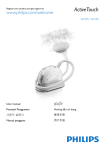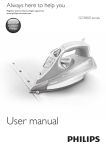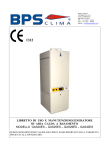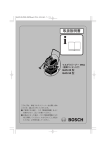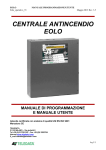Download Philips GC510/25
Transcript
Register your product and get support at 请于下述网站注册您的产品并获得产品支持 www.philips.com/welcome GC500 Series 1 GC500 Series English 6 简体中文 12 6 English Introduction Congratulations on your purchase and welcome to Philips! To fully benefit from the support that Philips offers, register your product at www.philips.com/welcome. General description (Fig. 1) A Steamer handle B On/off button C Steam buttons (GC526/GC525/GC520 only) -- single cloud = low steam output -- double cloud = high steam output D Filling opening with cap E Water tank F Drainage opening with cap G Filling cup H Steamer head holder (GC520/GC511/GC510 only) I Glove (GC526/GC525/GC520/GC511 only) J Steamer head K Mains cord with plug L Recesses for securing steamer head (GC520/GC511/GC510 only) MSteamer N Steam supply hose O Hanging accessory (GC526/GC525/GC515 only) Important Read this user manual carefully before you use the appliance and save it for future reference. Danger -- Never immerse the appliance in water or any other liquid, nor rinse it under the tap. -- Beware of hot steam that comes out of the steamer. Steam can cause burns. Warning -- Check if the voltage indicated on the appliance corresponds to the local mains voltage before you connect the appliance. -- Do not use the appliance if the plug, the mains cord, the supply hose or the appliance itself shows visible damage, or if the appliance has been dropped or leaks. -- Always return the appliance to a service centre authorised by Philips for examination or repair. Do not attempt to repair the appliance yourself, otherwise the guarantee becomes invalid. -- If the mains cord or the supply hose is damaged, you must have it replaced by Philips, a service centre authorised by Philips or similarly qualified persons in order to avoid a hazard. -- Never leave the appliance unattended when it is connected to the mains. -- This appliance is not intended for use by persons (including children) with reduced physical, sensory or mental capabilities, or lack of experience and knowledge, unless they have been given supervision or instruction concerning use of the appliance by a person responsible for their safety. -- Children should be supervised to ensure that they do not play with the appliance. -- The nozzle of the steamer head can become extremely hot and may cause burns if touched. -- Always unplug the appliance before you clean it or before you refill the water tank. Caution -- Only connect the appliance to an earthed wall socket. -- Do not use the appliance when it is placed on a table or chair. Only use the appliance when it is placed on the floor. If the hose forms a U-shape, steam condenses in the hose and this causes irregular steam or water droplets to come out of the steamer head. English 7 -- Check the mains cord and the supply hose regularly for possible damage. -- Do not let the mains cord and supply hose come into contact with hot steam when it the appliance is in operation. -- When you have finished steaming, when you clean the appliance and also when you leave the appliance even for a short while, switch off the appliance and remove the mains plug from the wall socket. -- Do not move the appliance while it is in use. -- This appliance is intended for household use only. -- Never drag or pull the appliance across the floor. Type of water to be used -- Do not put perfume, vinegar, starch, descaling agents, ironing aids or other chemicals in the water tank. -- You can use normal tap water. If the tap water in your area is very hard, we advise you to mix it with an equal amount of distilled water. Electromagnetic fields (EMF) This Philips appliance complies with all standards regarding electromagnetic fields (EMF). If handled properly and according to the instructions in this user manual, the appliance is safe to use based on scientific evidence available today. Filling the water tank Note:You can use normal tap water. If the tap water in your area is very hard, we advise you to mix it with an equal amount of distilled water. Do not put perfume, vinegar, starch, descaling agents, ironing aids or other chemicals in the water tank. Do not fill the water tank beyond the MAX indication. Note: Always empty the water tank before you refill it. 1Open the cap of the filling opening. 2Fill the water tank up to the MAX level with the filling cup supplied (Fig. 2). 3Close the cap of the filling opening (‘click’). Note:You can refill the water tank at any time. Always unplug the appliance before you start to refill the water tank. Using the appliance -- Make sure the water level in the water tank is above the MIN level at all times. -- To prevent the hose from forming a U-shape, always place the steamer on the floor to ensure that the hose is straight. If you hear an excessive croaking sound or if the steam output is irregular, lift the steamer head from time to time to straighten the hose. This allows any condensation to flow back into the water tank (Fig. 3). -- When you use the steamer, steam condenses inside the hose. When the hose forms a U-shape, this condensation cannot flow back into the water tank and causes a croaking sound and irregular steam output. To prevent this as much as possible, always place the steamer on the floor to ensure that the hose is straight. If you hear an excessive croaking sound or if the steam output is irregular, lift the steamer head from time to time to straighten the hose. This allows any condensation to flow back into the water tank (Fig. 4). 8 English 1Put the mains plug in an earthed wall socket (Fig. 5). 2Press the on/off button on top of the appliance to switch on the appliance (Fig. 6). -- GC515/GC511/GC510: The on/off button lights up. -- GC526/GC525/GC520: The steam button for high steam output lights up. 3Let the water in the steam tank heat up. This takes approximately 2 minutes. -- GC515/GC511/GC510: When the water in the water tank is ready for steaming, steam comes out of the steamer head. -- GC526/GC525/GC520: Press the appropriate steam button to select the desired steam output (single cloud = low steam output, double cloud = high steam output) (Fig. 7). Steaming garments Never direct the steam at people. Do not touch the steamer head nozzle while you are steaming. Keep it at a distance of at least 20cm from your body to prevent scalding. Note:The steam supply hose becomes warm during steaming.This is normal. Recommended ways to remove creases: -- Front of the collar: (Fig. 8) Hold one tip of the collar with one hand. With the other hand, move the steamer head to and fro as shown by the arrows in the figure. -- Back of the collar: (Fig. 9) Pull down the collar and hold one tip of the collar with one hand. With the other hand, move the steamer head to and fro as shown by the arrows in the figure. -- Front: (Fig. 10) Move the steamer head up and down as shown by the arrows in the figure. -- Pocket: (Fig. 11) Hold the front of the garment with one hand. Move the steamer head upwards as shown by the arrow in the figure. -- Back of the garment: (Fig. 12) Move the steamer head up and down as shown by the arrows in the figure. -- Sleeve: (Fig. 13) Hold the cuff of the sleeve with one hand. With the other hand, move the steamer head to and fro as shown by the arrows in the figure. Steamer head holder (GC520/GC511/GC510 only) You can use the steamer head holder to hang the steamer head on when you have to stop steaming for a moment, e.g. when you have to turn around the piece of clothing you are steaming. Hang the steamer head holder somewhere within reach of the garment you are steaming, for example on a garment rack. Glove (GC526/GC525/GC520/GC511 only) Put the glove on the hand you are using to hold a garment. The glove protects your hand against the steam from the steamer head. Hanging accessory (GC526/GC525/GC515 only) The steamer comes with a hanging accessory on which you can place your steamer, hang the garment for steaming, or hang the steamer head whenever you need to pause. Note: Position the hanging accessory with the steamer in the right direction (Fig. 14). Caution: Make sure the steamer is positioned in such a way that the supply hose connection points away from you and the supply hose does not get in the way. (Fig. 15) English 9 Emptying the water tank after use Always empty the water tank after use. 1Press the on/off button to switch off the appliance (Fig. 16). Note: It is normal that steam continues to come out of the steamer head for approx. 5 seconds after you switch off the appliance. 2Remove the mains plug from the wall socket (Fig. 17). 3Let the appliance cool down for at least 5 minutes. 4Turn the cap of the drainage opening to the ‘unlocked’ position and empty the water tank into the sink (Fig. 18). Note:The cap of the drainage opening cannot be removed from the water tank. 5 Turn the cap of the drainage opening to the ‘locked’ position. Storage 1Switch off and unplug the appliance (Fig. 17). 2Empty the water tank (see chapter ‘Using the appliance’, section ‘Emptying the water tank after use’). 3Turn the steam supply hose anticlockwise (1), wind it around the steamer base (2) and place the steamer head in the recess on the side of the steamer (3) (Fig. 19). ,, The magnets in the recess secure the steamer head in place (GC520/GC511/GC510 only). 4 Wind the mains cord around the steamer base. (Fig. 20) 5 Store the appliance in a safe and dry place. GC526/GC525/GC515 1Place the steamer head in the holder provided on the hanging accessory. If required, adjust the height of hanging accessory for storage (Fig. 21). 2Wind the mains cord around the steamer base. 3Store the appliance in a safe and dry place. Cleaning and maintenance Always unplug the appliance before you clean it. Never use scouring pads, abrasive cleaning agents or aggressive liquids such as alcohol, petrol or acetone to clean the appliance. 1Clean the appliance and wipe any deposits off the steamer head with a damp cloth and a non-abrasive liquid cleaning agent. Emptying and rinsing the water tank Let the appliance cool down for approx. 5 minutes before you empty and rinse the water tank. To prevent an excessive amount of water from dripping out of the steamer head during steaming, follow the steps below after every 5 times of use: 10 English 1Fill the water tank up to the MAX level. 2Turn the cap of the drainage opening to the ‘unlocked’ position. 3Tilt the appliance to an angle of approx. 45° and empty the water tank into the sink. Make sure there is no more water flowing out of the drainage hole. 4Repeat steps 1, 2 and 3. 5 Turn the cap of the drainage opening to the ‘locked’ position. Replacement You can order the following items from a Philips service centre: -- steamer head holder -- filling cup -- glove -- hanging accessory Environment -- Do not throw away the appliance with the normal household waste at the end of its life, but hand it in at an official collection point for recycling. By doing this, you help to preserve the environment (Fig. 22). Guarantee and service If you need service or information or if you have a problem, please visit the Philips website at www. philips.com or contact the Philips Consumer Care Centre in your country. You find its phone number in the worldwide guarantee leaflet. If there is no Consumer Care Centre in your country, go to your local Philips dealer. Troubleshooting This chapter summarises the most common problems you could encounter with the appliance. If you are unable to solve the problem with the information below, contact the Consumer Care Centre in your country. Problem Possible cause Solution The appliance does not heat up. There is a connection problem. Check the mains plug and the wall socket. You have not switched on the appliance. Press the on/off button to switch on the appliance. The steamer has not heated up sufficiently. Let the appliance heat up for approx. 2 minutes. The appliance does not produce any steam. Steam has condensed in the hose. Lift the steamer head to straighten the hose. This allows any condensation to flow back into the water tank. The water level is below the MIN level indication. Fill water tank to the MAX level indication. English 11 Problem The steam output is irregular. Water droplets drip from the steamer head. Possible cause Solution You have placed the steamer on a table or chair instead of on the floor. Place the steamer on the floor. Steam has condensed in the hose or in the steamer head. Lift the steamer head to straighten the hose. This allows any condensation to flow back into the water tank. You have placed the steamer on a table or chair instead of on the floor. Place the steamer on the floor. Steam has condensed in the hose. Lift the steamer head to straighten the hose. This allows any condensation to flow back into the water tank. You have left the steamer head Lift the steamer head to straighten and/or the steam supply hose in the hose. This allows condensation to horizontal position for a long time. flow back into the water tank. The appliance produces a croaking sound. You have placed the steamer on a table or chair instead of on the floor. Place the steamer on the floor. When the hose forms a U-shape, condensation present in the hose cannot flow back into the water tank. Lift the steamer head to straighten the hose. This allows any condensation to flow back into the water tank. Lift the steamer head to straighten You have left the steamer head the hose. This allows condensation to and/or the steam supply hose in horizontal position for a long time. flow back into the water tank. You have not placed the steamer The steamer head head in the recess properly. does not stay fixed when I try to store it. Wind the hose anticlockwise around the steamer base and place the steamer head in the recess. See chapter ‘Storage’. Water spills out of the filling opening when the cap is closed. You have put too much water in the water tank Do not fill the water tank above the MAX level indication. An excessive amount of water drips out of the steamer head when the appliance is heating up. The water in the appliance is dirty Remove all water from the water tank and rinse it with clean water or has been left inside the (see chapter ‘Cleaning and appliance for a long time. maintenance’). 12 简体中文 简介 感谢您的惠顾,欢迎光临飞利浦!为了您能充分享受飞利浦提供的支持,请在 www.philips.com/welcome 上注册您的产品。 一般说明 (图 1) A B C --D E F G H I J K L M N O 蒸汽挂烫机手柄 开/关按钮 蒸汽按钮(仅限于 GC526/GC525/GC520) 单口蒸汽喷出 = 低蒸汽输出量 双口蒸汽喷出 = 高蒸汽输出量 带盖的注水口 水箱 带盖的排水口 注水杯 蒸汽喷头支架(仅限于 GC520/GC511/GC510) 防烫手套(仅限于 GC526/GC525/GC520/GC511) 蒸汽挂烫机蒸汽喷头 带插头的电源线 固定蒸汽挂烫机蒸汽喷头的凹槽 (仅限于 GC520/GC511/GC510 ) 电蒸锅 蒸汽输送管 悬挂配件(仅限于 GC526/GC525/GC515) 注意事项 使用本产品之前,请仔细阅读本使用说明书,并妥善保管以备日后参考。 危险 -- 不要将本产品浸入水或其它液体中,也不要在水龙头下冲洗。 -- 小心挂烫机产生的热蒸汽。蒸汽可能会导致烫伤。 警告 -- 在将产品连接电源之前,请先检查产品所标电压与当地的供电电压是否相符。 -- 如果插头、电源线、蒸汽输送管或产品本身已经明显损坏,或产品曾坠落或出现渗 漏,请勿再使用产品。 -- 产品只能送到由飞利浦授权的维修中心检修。不要自己修理产品,否则产品维修保证 书将会无效。 -- 如果电源软线和蒸汽输送管损坏,为避免危险,必须由制造厂或其维修部或类似的专 职人员来更换。 -- 在产品接通电源期间,使用者不得离开。 -- 本产品不打算由肢体不健全、感觉或精神上有障碍或缺乏相关经验和知识的人(包括 儿童)使用,除非有负责他们安全的人对他们使用本产品进行监督或指导。 -- 应照看好儿童,确保他们不玩耍本产品。 -- 蒸汽挂烫机蒸汽喷头的喷嘴会变得非常烫,如触摸喷嘴,则会导致烫伤。 -- 在清洁产品或向水箱中注水之前,务必拔下产品的电源插头。 注意 -- 产品只能使用带接地线的插座。 -- 请勿将产品置于桌子或椅子上使用。仅当产品置于地板上时方可使用。如果蒸汽输送 管处于 U 形状态,则蒸汽会在输送管内冷凝,从而导致蒸汽输出不连贯或蒸汽喷头中 滴出水滴。 -- 经常检查电源线和蒸汽输送管是否损坏。 -- 产品工作期间,切勿让电源线和蒸汽输送管与高温蒸汽接触。 简体中文 13 -- 当完成熨烫、清洁产品以及短时间离开产品时,请关闭产品电源,并从电源插座上拔 下电源插头。 -- 使用期间,请勿移动本产品。 -- 本产品仅限于家用。 -- 切勿在地板上拖拉本产品。 应使用的水质类型 -- 切勿将香水、醋、淀粉、除垢剂、烫衣剂或其它化学品注入水箱内。 -- 您可以使用普通的自来水。如果您当地的自来水硬度很高,建议将其与等量的蒸馏水 混合使用。 电磁场 (EMF) 这款飞利浦产品符合关于电磁场 (EMF) 的相关标准。据目前的科学证明,如果正确使用并 按照本用户手册中的说明进行操作,本产品是安全的。 给水箱注水 注意: 您可以使用普通的自来水。如果您当地的自来水硬度很高,建议将其与等量的蒸馏 水混合使用。 切勿将香水、醋、淀粉、除垢剂、烫衣剂或其它化学品注入水箱内。 切勿让水位超过最大 (MAX) 水位标示。 注意: 重新注水前应始终倒空水箱。 1打开注水口的盖子。 2使用随附的注水杯向水箱内注水至最高 (MAX) 水位标示。 (图 2) 3盖上注水口的盖子(可听到“咔哒”一声)。 注意: 您随时可以为水箱加水。在向水箱中注水之前,务必拔下产品的电源插头。 使用本产品 -- 请确保水箱内的水位始终保持在最低 (MIN) 水位标示以上。 -- 为防止蒸汽输送管处于 U 形状态,请务必将蒸汽挂烫机置于地板上,以确保蒸汽输送 管处于竖直状态。如果您听到很大的咕噜声或蒸汽输出不连贯,请不时地提起蒸汽挂 烫机蒸汽喷头以拉直蒸汽输送管。这样做可使冷凝水流回水箱中。 (图 3) -- 使用蒸汽挂烫机时,蒸汽会在输送管内冷凝。当蒸汽输送管处于 U 形状态时,冷凝水 不能流回水箱中,将发出咕噜声并喷出不规则的蒸汽。要尽量防止此情况发生,请始 终将蒸汽挂烫机置于地板上,以确保蒸汽输送管处于竖直状态。如果您听到很大的咕 噜声或蒸汽输出不连贯,请不时地提起蒸汽挂烫机蒸汽喷头以拉直蒸汽输送管。这样 做可使冷凝水流回水箱中。 (图 4) 1将插头插入有接地的电源插座。 (图 5) 2按下产品顶部的开/关按钮,打开产品电源。 (图 6) -- GC515/GC511/GC510:开/关按钮将亮起。 -- GC526/GC525/GC520:高蒸汽输出量对应的蒸汽按钮将亮起。 3将蒸汽箱中的水加热。此过程需要约 2 分钟。 -- GC515/GC511/GC510:当水箱中的水可用于蒸汽熨烫时,蒸汽喷头会喷出蒸汽。 -- GC526/GC525/GC520:按下相应的蒸汽按钮以选择所需的蒸汽输出量(单口蒸汽喷 出 = 低蒸汽输出量,双口蒸汽喷出 = 高蒸汽输出量) (图 7) 14 简体中文 熨烫衣物 不要将蒸汽直接对着他人。 熨烫时,切勿触摸蒸汽喷头的喷嘴。将其与身体保持至少 20 厘米的距离,以免烫伤。 注意: 蒸汽熨烫期间,蒸汽输送管会变热。这是正常现象。 建议的除皱方法: -- 衣领正面: (图 8) 用一只手拉着衣领的一端,另一只手按图中箭头所示的方向来回移动蒸汽喷头。 -- 衣领背面: (图 9) 拉下衣领,用一只手拉着衣领的一端,另一只手按图中箭头所示的方向来回移动蒸汽喷头。 -- 正面: (图 10) 按图中箭头所示的方向上下移动蒸汽喷头。 -- 衣袋: (图 11) 用一只手拉着衣物的正面,按图中箭头所示的方向向上移动蒸汽喷头。 -- 衣物背面: (图 12) 按图中箭头所示的方向上下移动蒸汽喷头。 -- 袖子: (图 13) 用一只手拉着袖口,另一只手按图中箭头所示的方向来回移动蒸汽喷头。 蒸汽喷头支架(仅限于 GC520/GC511/GC510) 如有必要停止熨烫一段时间,例如要转动正在熨烫的布块时,您可以使用蒸汽喷头支架来 悬置蒸汽喷头。 将蒸汽喷头支架悬置在可接触到所熨烫衣物的位置,例如悬置在挂衣架上。 防烫手套(仅限于 GC526/GC525/GC520/GC511) 将防烫手套戴在拿着衣物的手上。防烫手套可保护您的手不被蒸汽喷头所喷出的蒸汽烫伤。 悬挂配件(仅限于 GC526/GC525/GC515) 蒸汽挂烫机推出了悬挂配件,您可将蒸汽挂烫机放在悬挂配件上,悬挂熨烫衣物,或在需 要暂停时悬挂蒸汽喷头。 注意: 请以正确的方向放置蒸汽挂烫机和悬挂配件。 (图 14) 注意: 确保正确放置蒸汽挂烫机,使蒸汽输送管连接不指向您并确保蒸汽输送管不阻碍操 作。 (图 15) 使用后倒空水箱 使用后,始终倒空水箱。 1按开/关按钮关闭产品电源。 (图 16) 注意: 关闭产品后,蒸汽喷头中会继续喷出蒸汽,持续大约 5 秒钟,这是正常现象。 2将插头从电源插座中拔下: (图 17) 3让本产品充分冷却至少 5 分钟。 4将排水口的盖子转至“解锁”位置,将水箱中的水全部倒进水池。 (图 18) 注意: 排水口的盖子无法从水箱上卸下。 5将排水口的盖子转至“锁定”位置。 简体中文 15 存储 1关闭产品电源并拔出电源插头。 (图 17) 2倒空水箱(见“使用产品”章节中的“使用后倒空水箱”部分内容)。 3逆时针旋转蒸汽输送管 (1),将其缠绕在蒸汽挂烫机底座上 (2),并将蒸汽喷头置于蒸 汽挂烫机侧面的凹槽内 (3)。 (图 19) ,, 凹槽内的磁铁可固定蒸汽喷头。 (仅限于 GC520/GC511/GC510 ) 4将电源线缠绕到蒸汽挂烫机底座上。 (图 20) 5将本品存放在安全干燥的地方。 GC526/GC525/GC515 1将蒸汽挂烫机蒸汽喷头装到随悬挂配件提供的支架上。如有必要,请调整悬挂配件的 高度以便于存储。 (图 21) 2将电源线缠绕到蒸汽挂烫机底座上。 3将本品存放在安全干燥的地方。 清洁和保养 清洁产品前,务必先将电源插头拔掉。 切勿使用钢丝绒、研磨性清洁剂或腐蚀性液体(例如酒精、汽油或丙酮)来清洁产品。 1用湿布和非腐蚀性液体清洁剂清洁本产品,并擦去蒸汽喷头中的沉积物。 倒空和清洗水箱 倒空和清洗水箱前,请让产品冷却大约 5 分钟。 为避免熨烫过程中过多的水从蒸汽喷头滴出,请每使用 5 次后按照以下步骤执行操作: 1将水注入水箱,至最高水位 (MAX)。 2将排水口的盖子转至“解锁”位置。 3将产品倾斜大约 45 度并将水箱中的水全部倒到水池中。确保排水孔不再有水流出。 4重复步骤 1、2 和 3。 5将排水口的盖子转至“锁定”位置。 更换 您可以从飞利浦服务中心订购以下备件: -- 蒸汽喷头支架 -- 注水杯 -- 防烫手套 -- 悬挂配件 环保 -- 弃置产品时,请不要将其与一般生活垃圾堆放在一起;应将其交给官方指定的回收中 心。这样做有利于环保。 (图 22) 保修与服务 如果您需要服务或更多信息,或者有任何疑问,请访问飞利浦网站:www.philips.com。 您也可与您所在国家/地区的飞利浦客户服务中心联系(可从全球保修卡中找到其电话号 码)。如果您所在的国家/地区没有飞利浦客户服务中心,请与当地的飞利浦经销商联系。 16 简体中文 故障种类和处理方法 本章归纳了使用本产品时最可能遇到的问题。如果您无法根据下面的信息解决问题, 请与贵国(地区)的飞利浦客户服务中心联系。 问题 可能的原因 解决方法 产品不能加热。 接触不良。 检查电源插头和电源插座。 您没有打开产品电源。 按开/关按钮启动产品。 蒸汽挂烫机未充分加热。 让产品预热约 2 分钟。 有蒸汽凝结在输送管内。 提起蒸汽喷头以拉直蒸汽输送管。 这样做可使冷凝水流回水箱中。 水位低于最低 (MIN) 水位标 示。 向水箱内注水至最高 (MAX) 水位标 示。 您将蒸汽挂烫机放在了桌子 或椅子上,而不是地板上。 将蒸汽挂烫机置于地板上。 输送管或蒸汽喷头内有蒸汽 冷凝。 提起蒸汽喷头以拉直蒸汽输送管。 这样做可使冷凝水流回水箱中。 您将蒸汽挂烫机放在了桌子 或椅子上,而不是地板上。 将蒸汽挂烫机置于地板上。 有蒸汽凝结在输送管内。 提起蒸汽喷头以拉直蒸汽输送管。 这样做可使冷凝水流回水箱中。 蒸汽喷头和/或蒸汽输送管 水平摆放了较长时间。 提起蒸汽喷头以拉直蒸汽输送管。 这样做可使冷凝水流回水箱中。 您将蒸汽挂烫机放在了桌子 或椅子上,而不是地板上。 将蒸汽挂烫机置于地板上。 当蒸汽输送管处于 U 形状 态时,输送管内的冷凝水不 能流回水箱中。 提起蒸汽喷头以拉直蒸汽输送管。 这样做可使冷凝水流回水箱中。 蒸汽喷头和/或蒸汽输送管 水平摆放了较长时间。 提起蒸汽喷头以拉直蒸汽输送管。 这样做可使冷凝水流回水箱中。 当我想存放蒸汽喷 头时,无法将其固 定到位。 蒸汽喷头未正确置于凹槽 内。 将输送管逆时针缠绕在蒸汽挂烫机 底座上,并将蒸汽喷头置于凹槽内 (见“存储”一章)。 盖上注水口的盖子 时,注水口有水溢 出。 水箱中盛放了过多的水 请勿让水位超过最高 (MAX) 水位标 示。 产品加热时有水从 蒸汽喷头中滴出。 产品中的水变脏或留在产品 很长时间。 倒掉水箱中的所有水并用清水进行 冲洗(见“清洁和保养”一章)。 产品不能产生蒸 汽。 蒸汽输出不连贯。 有水滴从蒸汽喷头 中滴出。 产品发出咕噜声。 简体中文 17 3 4 5 6 7 8 9 10 11 12 13 14 15 16 17 18 19 20 21 ml 000 00 00 ml 00 ml 800 ml ml 2 1 2 1 2 22 3 4239.000.7897.5




















